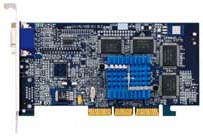Gigabyte GA-MG400 Matrox G400 AGP
by Anand Lal Shimpi on February 3, 2000 4:02 AM EST- Posted in
- GPUs
Just under a year ago, Matrox dazzled the market with the release of their G400 chip. The G400 was a contender, during the time of the TNT2 and the Voodoo3, that went in somewhat of a different direction than both NVIDIA’s and 3dfx’s products.
Instead of focusing entirely on performance, the G400 brought to the table some very useful features that, when push came to shove, helped put cards based on the G400 in systems that would have otherwise held a TNT2 or a Voodoo3.
Features such as DualHead, the ability to output to two monitors using a single G400 card, and Environment Mapped Bump Mapping, a feature used to increase the realism of textures by adding “bumps” without increasing polygon count, both soon became buzzwords that had the entire industry talking about.
When the competitors announced their next generation products, some of the first questions to be asked were “does it support Environment Mapped Bump Mapping?” and “will you have a DualHead option?” It is clear that Matrox made quite an impact on the consumer level 3D card market with the release of that one chip.
While the performance of the G400 was and still continues to be quite competitive, the solution lost in terms of the best hardcore gaming solution and thus never gained the acceptance into the gaming market that Matrox had originally hoped for. Part of the reason of the poor acceptance from gamers, who decided to go for a TNT2 or Voodoo3 based solution instead, was because of the relative unavailability of G400 based cards as well as the very high price tag that the top of the line G400MAX carried.
Had the cards been available back in May of 1999 when Matrox first officially announced the cards, even at the prices they debuted at, there would be a few less TNT2 and Voodoo3 owners around today and a few more satisfied Matrox customers. But, that wasn’t the case, and although Matrox worked their hardest to make sure that they didn’t make the same mistakes with the execution of the G400’s release as they did with the G200, they created new pitfalls in the process.
In an attempt to correct one of their major mistakes, although a bit late, Matrox signed a deal with Gigabyte to allow them to produce graphics cards based on the G400 chipset. Since Matrox wanted to remain the sole producer and manufacturer of retail boards based on the G400 yet also wanted to gain increased market acceptance, they went to Gigabyte with a unique offer.











0 Comments
View All Comments